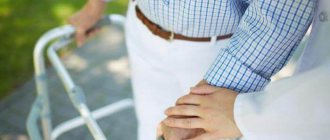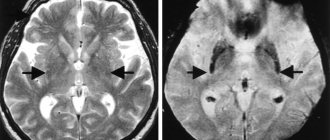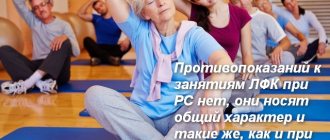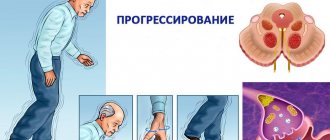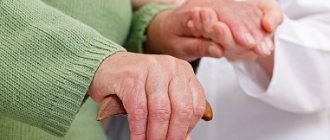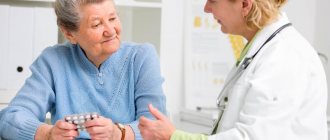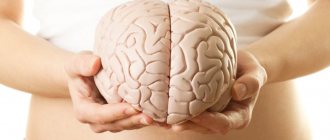Parkinson's disease is a severe brain pathology associated with a disorder in the metabolism of dopamine, which regulates the conduction of nerve impulses. With its deficiency, motor activity suffers: muscle tone increases, they begin to contract slowly and with difficulty, and the person is not able to move at the usual pace. In such situations, drug therapy for Parkinson's disease is supplemented with physical therapy for all muscle groups.
Features of the treatment of Parkinson's disease with physical exercises
Against the background of constant muscle tension, a patient with parkinsonian disorders changes his posture, his gait becomes shuffling, his movements are slow, tremors in the limbs and balance problems appear. In the final stages of the disease, the patient becomes completely immobilized due to impaired functional activity of the muscles.
Treatment of patients with parkinsonism includes drugs based on levodopa, which replenish dopamine deficiency, as well as elements of physical and breathing exercises, exercise therapy in combination with medications act as follows:
- Reduces tone in tense muscles (this also reduces trembling);
- Restore mobility in the cervical, thoracic and lumbar spine;
- Regulate coordination of movements;
- Normalize motor skills and gait;
- Increased thoracic kyphosis is leveled;
- Increase range of movements;
- Improves mood and general condition.
Exercise therapy for Parkinson's
A set of training for Parkinson's includes exercises to maintain the tone of all muscles. However, much attention is paid to breathing exercises, as well as exercises for coordination and maintaining the rhythm of walking. Daily exercise therapy classes help the patient cope with stress, as well as elevate mood and improve well-being.
The following exercises are distinguished for Parkinson's:
1. Classes to improve diction;
2. Voice volume training;
3. Development of smooth spelling;
4. Exercises for an even step and walking;
5. Control of stability and vestibular apparatus.
Is there a difference between exercise therapy and therapeutic gymnastics? Gymnastics is used for prevention purposes, and exercise therapy involves the use of exercise equipment, physical activity and various devices. Therefore, gymnastics is part of exercise therapy; it is based on various breathing techniques and exercises.
A set of exercises useful for Parkinson's disease
Each lesson should last at least 10 minutes and include the following elements:
- Power loads;
- Stretching tasks;
- Dynamic joint training;
- Mimic gymnastics;
- Breathing techniques.
Note!
The number of classes per day is determined individually by the physical therapy doctor and depends on the severity of the patient’s condition and the form of the disease.
It is recommended to do an average of 10-12 approaches.
Exercises to improve posture
- In a sitting position, we try to straighten our back as much as possible, resting our palms on the lumbosacral region.
- Still sitting, place your feet shoulder-width apart and place your palms on your waist. We lean back and forth. You can complete the task while holding the back of a chair.
- From a similar position, we tilt the body left and right.
- Lean against the wall so that only the occipital protuberance, shoulder blades, sacrum and heel bone are in contact with it. Press firmly with the interscapular area on the vertical surface.
Abdominal exercises
- Stretch out on the floor with your arms outstretched at right angles to your torso, palms up. Twist your body to the right, covering your left palm with your right, and vice versa.
- Lie on your back, pull your feet towards your buttocks. Raise your upper torso towards your hips. You can help yourself with your hands, hugging your knees with them and pulling your body forward.
- Lie flat, arms at your sides, feet facing you. Raise your head and shoulders, trying to see your toes.
- If possible, pump your abs in the classic way, with your hands behind the back of your head. In this case, an assistant can fix your legs in the area of the knees and shins.
Exercises for the neck and shoulder muscles
- We consistently bow our heads to one shoulder girdle and to the opposite one.
- We tilt the head to the chest and throw it back to improve mobility in the cervical vertebrae.
- We slowly turn our heads in one direction or the other, trying to examine the surface of the shoulder blades. In this case, there is no need to rush, so as not to provoke dizziness.
- We smoothly make circular movements with our heads, first pressing the chin to the chest, then the ear to the shoulder, the back of the head to the spine, the second ear to the shoulder girdle and back.
Exercises for the muscles of the shoulder girdle
- As you exhale, raise your shoulders up, and as you inhale, lower them. Significant tension in the muscles of the upper shoulder girdle should be felt.
- We place the fingertips on the shoulder joints and carry out rotational movements in them alternately anteriorly and posteriorly.
- We place our arms perpendicular to the body, bend them at the elbows, bringing our hands to the front surface of the shoulder joints. As you inhale, we try to connect the shoulder blades as much as possible; as you exhale, you should relax and take the starting position.
- Take a gymnastic stick in your hands, extend it in front of you parallel to the floor and pretend that you are working with an oar while rowing with one or the other hand.
Hand exercises
- We approach the wall at the length of an outstretched arm, rest our palms on it and smoothly lean forward, shifting our body weight onto our hands. We do not stick out our buttocks. Then we push off the wall with our hands and straighten up.
- We sit down at the table, placing our forearms on the tabletop with our palms down. We rhythmically turn the hands, either palmally or with the back surface up, moving faster and faster.
- We clench our fingers into fists and rotate our wrists, first inward, then outward.
- We take turns connecting the pads of our thumbs with all the others, gradually increasing the pace.
Exercises for the muscles of the lower limbs
- Lie down on the floor. Bend your left knee without lifting your sole off the floor. Place your right hand on your knee joint and pull it to the right for 10 seconds. Repeat with the other leg.
- Turn over face down, resting on your forearms. Bend your legs alternately at the knee joints, trying to touch your heel to the buttock area.
- We sit on the floor, stretch our legs forward. Rotate your feet first inward, then outward.
- We squeeze and straighten our toes.
Exercises to improve knee movement
- Sitting on a stool or on the edge of the bed, we straighten and bend our legs at the knee joints in turn.
- In the starting position from the previous exercise, stretch out the right leg and place it on a low stool. Sliding our hands along the front surface of the leg, we stretch as far as possible, touching the foot if possible. We freeze in this position for 10 seconds and straighten up. Repeat with the left leg.
- Sit on the floor, stretching your legs and resting your straightened arms on the floor slightly behind your back. Bend your legs at the knee joints, pulling your feet towards your pelvis, and return to their original position.
- Lie down on a horizontal surface and do the classic version of the “bicycle” exercise, simulating pressing the pedals.
Tension and relaxation of the thigh and calf muscles
- Leaning on the back of a chair on one side, we lunge forward alternately with one and then the other leg. We try to get down as close to the floor as possible and hold in this position for 15-20 seconds.
- Still holding onto the chair, we first stand on our tiptoes, stretching the calf muscles, and then again on the full sole, relaxing.
- We perform regular or half squats at a support.
- We lie on our backs straight and alternately raise our straightened legs up as far as possible.
Parkinson's disease and parkinsonism. Brief information
Parkinson's disease (PD) is a chronic progressive degenerative disease of the central nervous system (CNS), clinically manifested by impairment of voluntary movements. It is customary to distinguish between the concepts of PD and parkinsonism. Parkinsonism is a syndrome whose leading clinical manifestations are: hypokinesia (an obligatory sign), muscle rigidity, resting tremor, postural instability. Parkinsonism, in turn, is divided into primary, secondary, and also parkinsonism with multisystem degenerations of the central nervous system.
The classification of PD includes clinical form, stage and rate of progression.
Depending on the dominance of a particular symptom in the clinic, three clinical forms are distinguished: akinetic-rigid-tremor (60-70%), akinetic-rigid (15-20%) and tremulous (5-10%).
With regard to the clinical stage of the disease, the following classification of stages (degrees of severity) of PD is generally accepted:
Stage 0. There are no motor manifestations;
Stage 1. Unilateral manifestations of the disease;
Stage 2. Bilateral manifestations of the disease without postural instability;
Stage 3. Moderate postural instability, independent movement is possible;
Stage 4. Significant loss of motor activity, but the patient is able to walk;
Stage 5: In the absence of outside assistance, the patient is bedridden or wheelchair-bound.
There is also a modified Hoehn and Yahr scale (Hoehn, Yahr, 1967), which was first published by Margaret Hoehn and Melvin Yahr in 1967.
Modified Hen and Yahr scale:
Stage 0.0
– there are no signs of parkinsonism
(this stage is characterized by the absence of clinical manifestations of the disease, however, structural changes are already beginning in the central nervous system. The disease at this stage is diagnosed very rarely, usually by chance)
;
Stage 1.0
– only unilateral manifestations
(patients experience unilateral tremor of the hand, the tremor is mild. As it progresses, changes in posture, facial expressions, gait appear, pain in the shoulder joint on the affected side may appear. A feeling of “sand in the eyes” may also appear , due to a reduction in the number of blinking movements of the eyelids.In patients, the time spent on shaving, combing and other daily manipulations increases)
;
Stage 1.5
– unilateral manifestations with the involvement of the axial muscles
(locomotor changes occur, a reduction in the amplitude of movements, pronounced rigidity of the facial and cervical muscles appears)
;
Stage 2.0
– bilateral manifestations without signs of imbalance
(disorders are bilateral in nature and are manifested by trembling of the hands, insufficient amplitude and stiffness. Involuntary shaking of the head occurs, and rigidity of the facial muscles leads to hypomimia (“mask-like” face)
;
Stage 2.5
– mild bilateral manifestations. The ability to overcome induced retropulsion is preserved;
Stage 3.0
– moderate or moderately severe bilateral manifestations.
Slight postural instability. But the patient does not need outside help (retropulsion becomes more pronounced. The patients have progressive stiffness of movements, and as a result of loss of balance, falls are possible. When walking, the patient presses his arms to his body, the length and height of the step is reduced - a sign of a “shuffling” gait. Despite the symptoms, the person continues to serve himself, partial ability to work remains
;
Stage 4.0
– severe immobility;
however, he can still walk or stand without support (significant hypokinesia develops, pronounced tremor of the head and limbs. Sometimes the tremor decreases. The patient is not able to perform physical work, self-care causes significant difficulties. Movements are performed with difficulty, gait becomes very slow. At this point stage, the patient needs additional means to maintain balance - a cane, crutches, walkers)
;
Stage 5.0
– confined to a chair or bed without assistance
(this stage of the disease is characterized by the loss of the ability to move independently. The patient moves with the help of a wheelchair, or he lies in bed all the time. From this moment on, the person needs constant care from relatives or medical personnel. Appear severe swallowing dysfunction, which leads to weight loss)
.
In addition, in PD it is customary to distinguish three types of disease progression rates: fast, moderate and slow. At a rapid pace, the change in stages of the disease (first - second / second - third) occurs within 2 years or less. At a moderate pace, the change of stages occurs in more than 2 years, but not more than 5 years. At a slow pace, the change of stages occurs after more than 5 years.
Clinical manifestations of PD are usually divided into motor and non-motor. Among the motor symptoms of the disease, the following should be highlighted: bradykinesia, rigidity, resting tremor, postural instability. Non-motor manifestations of PD include: olfactory disturbances, autonomic manifestations (dysfunction of the gastrointestinal tract, urination, sexual dysfunction, impaired sweating, postural hypotension, seborrhea), affective disorders, sleep disorders, psychotic disorders, cognitive impairment.
Along with the use of antiparkinsonian drugs and regardless of the clinical manifestations and stage of the disease, regular exercise therapy is of utmost importance for patients with PD. Special complexes of physical therapy can increase the effectiveness of drug therapy, reduce the negative clinical manifestations of the disease, especially such as postural instability, bradykinesia, orthopedic complications (for example, glenohumeral periarthritis, changes in posture, including those of the Leaning Tower of Pisa syndrome, etc. ), dysfunction of the gastrointestinal tract, and also significantly improve the patient’s quality of life by increasing daily physical activity. At the same time, physical therapy has no absolute contraindications, but requires a personalized approach to each patient and the selection of a set of exercises taking into account tolerance to physical activity, manifestations of functional neurological deficit, the presence or absence of any concomitant diseases, as well as a number of other factors influencing rehabilitation the patient’s potential and defining rehabilitation goals and objectives.
Exercises for facial muscles
In Parkinson's disease, not only skeletal muscles suffer: facial muscles also become less mobile, “waxy”. With the help of a special complex of physical therapy, the patient is able to get rid of the mask-like, amicable face and again actively express emotions. To better control the correct execution, you should practice in front of a mirror.
- Alternately portray surprise, joy, and anger on your face. Hold each expression for 3-5 seconds.
- Consistently raise your brow ridges, frown, and close your eyes tightly.
- Stretch and purse your lips tightly, then open them slightly and say “cheese.”
- First, at a slow and then at the fastest pace, stretch your lips, and then pull them out with a tube.
- Inflate and deflate your cheeks.
- Stick out your tongue and move it alternately left and right, up and down.
- “Draw” circles with the tip of your tongue, first clockwise and then counterclockwise.
Perform each exercise at least 10 times.
Important information!
Tongue exercises are necessary to prevent swallowing disorders. These disorders occur in the later stages of the disease and cause serious complications in the respiratory tract when food gets into them.
Physiotherapy for Parkinson's
It is used at any stage of the disease and is aimed at improving the functioning of organs and tissues. For this disease, electrophoresis with drugs, transcranial magnetic stimulation, running magnetic field magnetotherapy and pulsed electrotherapy are used.
Yoga
Suitable for any period of illness. Yoga is recommended as one of the methods of non-drug therapy. The impact of classes is positive, as shown by the results of research from the University of Mumbai. Motor performance improved by 29% in groups of patients doing yoga.
Recommendations for loads
The influence of training and exercise therapy on inhibiting the progression of the disease is very significant. But there are rules that must be followed to achieve maximum results, namely:
1. Do workouts every day;
2. Spend at least 20-30 minutes a day;
3. Exhaustion must not be tolerated;
4. Can be combined with household chores;
5. Practice with music to keep the rhythm going.
The complex must be approved by your instructor and must be approved by your attending physician. Do not conduct independent training without relevant experience.
Effects of physical activity
Scientists are constantly developing various techniques to adapt the patient to normal life. Expectations from daily training:
1. Reducing the required dose of drugs;
2. Getting rid of depression, improving mood;
3. Restoration of working capacity;
4. Relieving tremors and strengthening gait.
Breathing exercises
The function of the respiratory muscles in Parkinson's disease also suffers: the depth and efficiency of inspiration decreases. This is also facilitated by changes in posture and the formation of stoop. To restore the normal biomechanism of inhalation and exhalation, the following exercises are recommended:
- Sit on a stool or the edge of the bed and place your palms on the front abdominal wall. Inhale deeply, feeling your stomach inflate. Exhale slowly through pursed lips.
- Go to the wall and press your back against it so that your spine touches it along its entire length: from the lower cervical region to the sacrum. As you inhale, extend your arms upward, also along the wall. As you exhale, cross them over your chest.
- As you inhale, stand on your tiptoes, raise your arms up and stretch, while exhaling, stand on your full foot, bend down so that your arms hang freely.
Each time you need to do 10 breathing movements.
The basis of the gymnastics plan
The gymnastic plan for this disease consists of:
- exercises .
- Performing soft movements - exercises for joints.
- Exercises with dumbbells with a gradual increase in loads and replacing dumbbells with heavier ones.
- Breathing exercises.
- Walks in the fresh air.
- Massage.
The choice of one or another set of exercises depends on the stage and form of the disease, as well as on the individual characteristics of the patient’s health condition.
Initial stage of the disease
In the initial stages, patients are recommended:
- Walk on treadmill .
- Perform movements, increasing their amplitude.
- Perform swing movements, throw the ball with each hand in turn, kick the ball with your feet.
- Practice walking along a line and then along a narrow path equipped with obstacles.
- Simulate skiing and rowing.
- Take daily walks in the fresh air.
- Play some sports - badminton, golf, golf.
Expanded stage
The advanced stage is characterized by postural disturbances, the elimination of which requires the following:
- Do breathing exercises.
- Master special techniques that allow you to turn over in bed, sit down, stand up, and walk.
- Perform simple stretching exercises.
- Learn techniques to suppress tremor.
- Perform exercises to help restore normal posture.
- Practice holding the pose.
The advanced stage is accompanied by the patient’s loss of motor activity, “freezing” of joints and muscles. To reduce such unpleasant manifestations, it is useful for patients to practice walking under command signals, for example, “left-right”, or counting “one”, “two”, “three”.
Why can our articles be trusted?
We make health information clear, accessible and relevant.
- All articles are checked by practicing doctors.
- We take scientific literature and the latest research as a basis.
- We publish detailed articles that answer all questions.
Also, the set of exercises for patients with an advanced stage includes walking to marching music and walking with support or with the help of a little support from strangers.
Additional tips and tricks
When performing any exercise, you need to follow the rules to achieve the greatest effectiveness from your workout:
- You should exercise regularly, in accordance with the regimen prescribed by the doctor.
- It is advisable to start training after taking medications, when the symptoms of the disease are less pronounced, it becomes easier to move, and the patient’s physical activity increases.
- Before training, it is advisable to perform a light muscle massage to improve local blood flow and reduce spasm.
- You need to move slowly at first, then gradually increase the pace.
- Rhythm is very important, so it is better to practice with appropriate music or a loud score.
- You should not bring yourself to excessive fatigue. Normally, half an hour after finishing classes, your strength should be fully restored and your energy should appear.
- After completing the main gymnastic complex, time is allocated for breathing training.
Recommendations from experts!
In the early stages of Parkinson's disease, neurologists recommend not only classical exercise therapy, but also activities such as walking, skiing, swimming, cycling, playing volleyball, badminton, and golf. Patients should overcome a shuffling gait through regular long walks; through swimming, they should restore their usual posture; dynamic games help improve balance and posture.
Exercise therapy for Parkinson's disease is necessary primarily to maintain normal motor activity and the ability to move. With adequate drug therapy, physical activity slows down the progression of the process and makes the course of the disease easier, preventing the development of complications.
Material and methods
The study was conducted on the basis of the neurological department of the clinic (headed by T.N. Nikolaeva, candidate of medical sciences) of the Siberian State Medical University.
The sample consisted of 20 men with B.P. Patients were hospitalized in the department for selection and correction of drug therapy for the underlying disease in the period from 2016 to 2021.
The patients were divided into two groups of 10 people. Group 1 consisted of patients with a sports history. In their youth, they played sports for more than 5 years and achieved certain successes (adult sports category or the title of master of sports). Of these, 3 patients were engaged in wrestling (2 people - classical wrestling, 1 - sambo) and at the same time weightlifting, 6 patients - only weightlifting (barbell, kettlebell lifting), 1 - basketball and weightlifting. In the subsequent period of life, right up to hospitalization for the underlying disease, they continued to engage in strength physical activity (weight training machines, strength exercises) to the best of their physical capabilities. No head injuries accompanied by loss of consciousness were noted.
The patients were residents of the Tomsk, Novosibirsk regions and Altai Territory. In a rural area, in an urban village, 3 patients lived, the rest were city dwellers. Before the disease they all worked. By occupation, 5 people were employees (engineer, university and technical school teachers, school teacher, military man), 3 were workers (mechanic, 2 operators), 1 was an entrepreneur, 1 was a hunter.
Group 2 consisted of patients who did not engage in sports or physical education.
All patients were interviewed regarding their life history and illness. Particular attention was paid to the onset of PD, which the patient independently defined as the time period from the onset of at least one motor component of the disease, as well as the presence of a history of arterial hypertension (AH) and the duration of its course, the level of maximum systolic (SBP) and diastolic (DBP) values. blood pressure (BP) and the use of antihypertensive therapy.
A general examination was carried out in the morning on an empty stomach and included:
1. Anthropometric profile [height (cm) and body weight (kg) with calculation of body mass index - BMI (kg/m2)].
2. The strength component was determined by hand dynamometry [F hand (kg) with the calculation of the strength index of the right and left hands [IF hand (%)=(F hand/body weight)·100%]. Normal values for men are 65-80%.
3. The orthostatic reaction was studied when the patient moved from a lying position to a sitting position. We determined SBP and DBP in the supine position - SBP (L) and DBP (L), in the sitting position - SBP © and DBP ©, the difference δSBP=SBP (L)–SBP ©, the difference δDBP=DBP (L)–DBP ©.
4. Motor function was assessed using the unified B.P. scale. International Movement Disorder Society (MDS UPDRS Part III).
Statistical data processing was carried out using the Statistica 6.0 software package. The reliability of intergroup differences in values was determined using the nonparametric Mann-Whitney and Kruskal-Wallis tests. For qualitative discrete characteristics, cross-tabulation was used followed by analysis of contingency tables. The results are presented as M
±
SD
, where
M
is the arithmetic mean,
SD
is the standard deviation or
M
;
P50 [P25; P75], where M
is the arithmetic mean, P50 is the median, P25 is the 25th percentile, P75 is the 75th percentile.
The study was conducted in compliance with all basic bioethical rules and requirements, after obtaining the informed consent of patients to participate in it.
